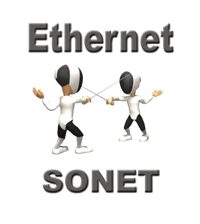Most medium to large businesses, and even some smaller ones with high bandwidth needs, can now afford fiber optic bandwidth. This is due to lower prices and a wider range of options, which is great news for those who need a lot of bandwidth. Let’s explore some of these options that you may not be aware of.
 Fiber optic bandwidth services generally fall into two categories: traditional time division multiplexed technology, originating from telephone company research, and newer IP-centric networks offered by both competitive service providers and traditional telecom carriers.
Fiber optic bandwidth services generally fall into two categories: traditional time division multiplexed technology, originating from telephone company research, and newer IP-centric networks offered by both competitive service providers and traditional telecom carriers.
The most recognizable fiber optic bandwidth service is OC-3, or Optical Carrier - level 3, which operates at 155.52 Mbps, commonly called 156 Mbps. Interestingly, some lower-speed services, such as T1 and DS3, typically considered copper-based, might use fiber optic cabling for part or all of the connection from the provider to your location. The carrier decides how to deliver their bandwidth, which is simplified because both T1 and DS3 can be easily combined onto OC-3.
This is possible because T1, DS3, and OC-3 were all created by the telephone industry. The basic unit is a DS0, carrying 64 Kbps of bandwidth (8 data bits x 8 Kbps sampling frequency), enough for one digitized phone call. Combining 24 DS0 channels forms a 1.5 Mbps T1 line, and combining 28 T1 lines (or 672 DS0 channels) forms a 45 Mbps DS3 service. Finally, combining 3 DS3 services creates an OC-3 at 156 Mbps. This combining and splitting process is managed by a device called an Add/Drop Multiplexer (ADM).
OC-3 is part of the SONET (Synchronous Optical NETwork) industry standard, while its international counterpart is SDH (Synchronous Digital Hierarchy). Higher speed fiber services within the OCx family are available, including OC-12 at 622 Mbps, OC-24 at 1.244 Gbps, OC-48 at 2.488 Gbps, OC-192 at 9.953 Gbps, and OC-768 at 39.812 Gbps, the latter primarily used by service providers.
SONET fiber optic services have been known for their high cost and limited availability for decades. Colocation centers, or carrier hotels, offered the best chance of accessing these high bandwidth services, as carriers have a presence there, eliminating construction costs. Connecting simply involves a fiber optic cable from their equipment to yours.
However, SONET services delivered directly to businesses have become more affordable due to growing demand and competition from Carrier Ethernet. This technology extends the familiar Ethernet of your LAN to metropolitan and wide area networks, commonly known as Metro Ethernet, and primarily found in major metropolitan areas.
Unlike synchronous TDM-based SONET, Metro Ethernet is a packet or IP-based network service. This eliminates the need for specialized interface circuitry to connect, as it uses standard Ethernet connectors. Additionally, it offers scalable speeds mirroring standard network speeds, such as 10 Mbps, 100 Mbps, 1000 Mbps, and now 10 Gbps. Many carriers provide a wider range, from 10 Mbps to 10 Gbps. By installing an Ethernet port at your highest anticipated speed, you can start with a lower bandwidth increment and upgrade as needed, often with a simple call to your provider.
Regarding pricing, SONET services might still be cheaper in some areas, but Ethernet generally holds the cost advantage, especially for non-standard SONET speeds. Choosing Ethernet over SONET for the same bandwidth can result in cost savings of 50% or more.
If you are currently using or considering fiber optic bandwidth services, make sure to compare prices for both SONET and Ethernet before making a decision. You might be surprised to find more affordable options than you expected.

